|
|
 |
|
Fuzz and Distortion Timeline
Since transistors are the heart and soul of every fuzz pedal, we should start here.
December 23 1947
The first transistor was successfully demonstrated at Bell Laboratories in New Jersey. The three individuals are credited with the invention; William Shockley, John Bardeen and Walter Brattain. This is widely reguarded as the birth of the "PNP point-contact germanium transistor". The transistor replaced the vacuum-tube triode. Transistors were smaller, used far power to operate, and generated less heat. These first transistors were Germanium. Germanium was difficult to purify and had a limited operational temperature range (Which is why fuzz pedals that use germanium transistors can change sound or stop working depending on the temperature).
January 26 1954
Morris Tanenbaum at Bell Laboratories developed the first working silicon transistor. A few months later Gordon Teal at Texas Instruments developed a similar device. Despite this, germanium remained the dominant semiconductor material for transistors and other semiconductor devices until the late 50's.
|
|
|
|
1962
Gibson Maestro FZ1 Fuzztone

|
One of the first instances of fuzz used in a song is probably the R&B hit 1951 ŌĆ£Rocket 88" by Ike Turner and His Kings of Rhythm. Producer Sam Phillips remembers the guitar amplifiers ŌĆ£fuzz toneŌĆØ being the result of a fall the roof of the bandŌĆÖs car on the way to Memphis. According to Phillips as a result of the fall the speaker had come loose and the amps interior was stuffed with newspaper to hold the speaker in place, creating its distorted "fuzzy" sound. Ike Turner recalled it differently, saying the amp had been rained on in the trunk of the car and this was what caused the accidental distorted sound.
Lee Hazelwood was an early pioneer of fuzz tone, it seems he had a fuzz box created by a radio station technician for use in the recording studio. Al Casey used this fuzz box in recording sessions for Sanford Clark's 1960 "Go On Home" track, released in March. This is one of the first instances of an electronic circuit being used to create a fuzz tone.
Also recorded in 1960 was the Marty Robbins track "Don't Worry", though not released until January 1961. A faulty preamp on the console caused Grady Martin's 6 string bass solo to come out very fuzzy. The recording engineer Glen Snoddy, soon devised a way to replicate the sound with a transistor circuit and pitched it to Gibson. This circuit would go on to become the Gibson Maestro Fuzztone.
Also in 1962, Red Rhodes built a custom one off fuzz box. Session guitarist Billy Strange used a Rhodes fuzz box on Ann Margaret's 1961 "I Just Don't Undertsand". The Ventures also used the Rhodes Fuzz on 1962 "2000 Pound Bee".
The first chart-topping track recorded using a commercially available fuzz box was the Rolling Stones ,1965 "Satisfaction", using the Gibson Maestro fuzztone.
Despite the availability of the Maestro Fuzztone, Dave Davies of "The Kinks" achieved his fuzz sound using an old school blues method, a torn speaker cone. In Davies case he had purposely slashed his speaker cone with a razor blade. He ran his "modified" amp through a AC30 to record the 1964 "You Really Got Me".
|
1965
Solasound MK I Tonebender
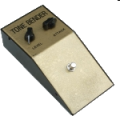
|
The tonebender was designed by Gary Stewart Hurst. The MK I was a three transistor circuit based on the Gibson Maestro Fuzz-tone that Hurst modified to produce more sustain.
You can hear the sounds of Jeff Beck's MK I on the Yardbirds track "Heartful of Soul". Mick Ronson used the MKI Tone Bender in David Bowie's Spiders from Mars band (Moonage Daydream).It was also Tonebender MK I that Paul used on his bass track for The Beatles 1965 "Think for Yourself".
|
1966
WEM-Rush Pep Box
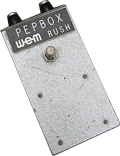
|
This fuzz derived it's curious name from the designer designer Pepe Rush. Rush was approached by Charlie Watkins,of Watkins Electric Music (WEM). WEM took over the marketing of the Rush Pep Box and shortly after modified it using silicon transistors instead of germanium. The deal foundered, when WEM incorporated the pedal into an amplifier. A dispute over royalties ensued, and Rush lost control of his own invention.
Apparently, the Beatles had two of them it may or may not have found its way onto "Revolver", specifically on "Tomorrow Never Knows"), and Edgar Broughton Band also used one.
|
1966
Solasound Tonebender MK I.5
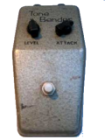
|
In early 1966 the Tone Bender swiched to a sand cast aluminium design finished in grey Hammerite paint.
It featured a newly designed two transistor circuit that used two Mullard OC75 devices.
This is the same circuit type that was used by Vox in their Italian Tone Bender production.
|
1966
Vox V816 Distortion Booster
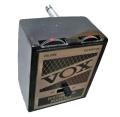
| Vox/JMI engineer Dick Denney designed this little 2 transistor fuzz box. It featured a built in plug and an on/off switch. It was basically the same circuit as the Fuzz Face and Tone Bender Mark 1.5, but was actually on the market in 1966 before the Fuzz Face, and appeared in an February '66 Vox price list and a June parts manual. There was also a V8161 version with a volume control, a V8163 version in a square plastic box with built in plug. The two transistor amplifier circuit found in these fuzz boxes circuits were based on a common text book amplifier design, and could be found transistor manuals in the early 1960's. Brian May of Queen used the VDB circuit inside his Red Special guitar for a period of time.
|
1966
Arbiter Fuzz-Face

|
In 1969 Arbiter redesigned the Fuzz-Face using Silicon transistors instead of Germanium.
David Gilmour used the Germanium version on "Corporal Clegg", "Let There Be More Light" and "Nile Song". He used a Silicon Fuzz-Face on "When You`re In", "Time", and "Money".
|
1966
Hornby Skewes Zonk Machine

|
The Zonk Machine was almost identical circuit wise to the Tonebender Mk I.
|
1966
Baldwin-Burns Buzzaround

|
The Buzzaround was a fuzz box produced in Britan by Baldwin buring the short time with Burns guitars (1965-68). This is definitely one of the rarest and hardest to track down items in Fuzz box history. The effect was desigend by father of the Tonebender MKI/II himself, Gary Hurst. The circuit used 3 germanium NKT213 transistors and is similar to the Tonbender MKII in design.
From Guitar Player Magazine (1974)
"On stage I use three pedals on a pedal board: A volume pedal, fuzz-tone, and wah-wah. The fuzz-tone and wah-wah are pretty rubbishy. I'm not sure what type of wah-wah it is. The best fuzz-box to use is a Burn's Buzz-around which they discontinued making in England about six years ago." -Robert Fripp, King Crimson
|
1966
Solasound MK II Tonebender
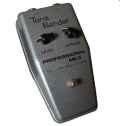
|
The Sola Sound Tone Bender Professional MKII was produced between 1966 and 1968. With the right kind of set-up it is one of the finest sounding British fuzz boxes ever made.
It should be noted the Marshall Supa Fuzz is the exact same circuit.
|
1966
Marshall Supafuzz

|
This is basiclly a Marshall branded MKII Tone Bender. It uses the exact same circuit.
|
1966
Vox Tone Bender
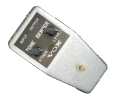
|
Made in 1966 the Vox Tone Bender had the longest run of all the tone benders as it was still being produced in some form or another untill the mid to late 1970's. Just like the Vox organs, these pedals were actually made in Italy by JEN.
The very first Vox Tone Benders did have slightly different component values but all had an OC76 transistor in the second position within the circuit. These early Vox units were fitted with a SFT337 and an OC76 transistors. David Main reports that models from 1967 still used the SFT337, but in place of the OC76 used a SFT363E. The design is based on the same circuit topology as the MKI.V design
The tone produced by this circuit can be a little shocking. The treble content is quite high for a fuzz pedal but makes for a very unique sounding effect and well suited for the dark sounding British valve amplifiers.
|
1966
Mosrite Fuzzrite
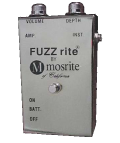
|
The Fuzzrite was designed by Ed Sanner, who worked at Mosrite at the time.
Early versions of the pedals used Germanium transistors, the circuit was later redesigned for Silicon transistors.
Around 1967 Guild contracted Morsite to build this circuit as their Foxey Lady fuzz. Approximately 1000 of these were made, before Mike Mathews of Electro Harmonix took over production for Guild.
The Fuzzrite circuit can be found in the ZB Custom fuzz and the Rosac Nu-Fuzz.
The Germanium version of this pedal was used on Iron Butterfly's 1968 track "In-A-Gada-Da-Vida".
|
1966
Selmer Buzz Tone

|
An early solid-state distortion unit Selmer introduced in September 1966.
The three-stage transistor circuit gave the Buzz-Tone a smoother distortion than other fuzz pedals.
It was an integral part of Syd Barrett's setup. Syd barrett of Pink Floyd used one in 1966-67.
|
1966
Astro Tone
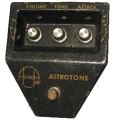
|
The Astro Tone Fuzz box was made in New York City by Astro Amp/Universal Amplifier Corp. The Astrotone was also rebranded for New York based Sam Ash music company as the Sam Ash Fuzz Box. The Sam Ash version was sold in the identical Astrotone enclosure, then moved into it's own enclosure. Minor changes to the circuit component values were made during the production. These were sold until around 1968.
|
Late 60's ?
Manny's Fuzz
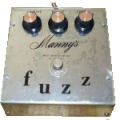
|
This was a fuzz box put out by another NYC icon, Manny's Music.
|
60's ?
Hofner Buzz tone

|
A german built effect that uses three BC108B silicon transistors.
This same pedal was amrketed under the name Halifax Buzz Tone.
|
1967
Roger Mayer Octavia

|
The most notable instances of this fuzz/octave pedal can he heard on the 1967 Jimi Hendrix tracks "Fire" and "Purple Haze".
|
1968
EHX Axis Fuzz

|
When Mike Mathews took over production of the Guild Foxey Lady in late 1967, the Axis fuzz was the circuit he used.
He would later move the Foxey lady to the Big Muff Pi circuit.
|
1968
Solasound MK III Tonebender

|
This is was the first version of the Tone Bender to feature a tone control. It's a three transistor circuit that came in several different enclosures. It was available under a number of different names and brands, including Vox (Tone Bender MKIII), Carlsbro (Fuzz), Park (Fuzz Sound) and CSL (Super Fuzz).
|
1968
Univox (Shin-ei FY-6) Super Fuzz

|
This circuit gained the most popularity under the Univox brand.
It was designed by Shin-ei and manufactured in Japan by Unicord.
You could find these circuits under a bunch of names..... Ibanez, Apollo, Companion, Shaftsbury, Mica, JAX, Kent, Teisco, Marlboro, and Royal to name a few. In the end, they are all the same FY6 Superfuzz. . Around 1970 unicord production changed to a die-cast metal box, featuring a rubber cover with "Super-Fuzz" embossed on it.
|
|
1968
Jordan Bosstone
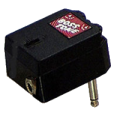
|
The Jordan company licensed the circuit to Sho-Sound/Music City, and there are a few different versions of the circuit exsist. Much appreciated. Version 1 was used on the initial production out of Alhambra CA, after this first run they changed the circuit. I've heard Sho-Sound kept the same 2nd Version Circuit through out their production. I've seen 5 different vesions of the Jordan circuit, so it changed a few more times during Jordan production.
|
1968
Fender Blender

|
It has controls for Volume, Sustain, Tone and Blend. There are two foot switches: On & Off, and Tone Boost. In addition to producing a variety of Fuzz/Distortion Tones, this pedal can create a range of warm distortions from a minor fuzz to an extreme pulsing screach. The pedal has a very bassy distortion, it can overload on the low end. Tone Enhancer Button gives the distortion a little high end boost. The production ran from 1968-77. The effect gained popularity in the 1990s via Billy Corgan of The Smashing Pumpkins. Recently the effect was reissued.
|
1968
Montarbo Sinphoton

|
An Italian made fuzz pedal with two clipping diode stages. I've seen this effect in a few different housings, the original boards used "goop" to obscure the circuit and prevent copies.
|
1969
Ampeg Scrambler
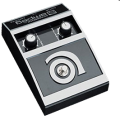
|
The Ampeg Scrambler ranks among the rarest of effects pedals.
It features a distortion circuit that adds upper octave harmonic content, while blending a unique overdrive effect to the signal.
It has been noted that perhaps fewer than 2500 units were ever made. It's best been described as a NASTY sounding fuzz.
|
1969
EHX Muff Fuzz

|
The Muff Fuzz was a mild overdrive circuit in an LPB-1 box. The analog two transistor fuzz pedal was dubbed ōmuffö because in his words it had a ōfunky, soft, muffled soundö.
|
1969
Big Muff Pi "Triangle" v1

|
Mike Mathews buit the first Big Muff in 1969 as a prefboard prototype.
An etched production version of the board went out in early 1970.
The "Triangle" nickname comes from the layout of the controls.
This version uses PNP transistors. The sound is a very musical distorsion with lots of sustain.
Used by David Gilmour on part of the On An Island tour.
Also note there is a second version of the "Triangle" big muff that uses NPN transistors.
The sound is about the same with a little less gain.
|
1969
Jennings Fuzz
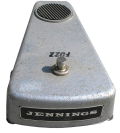
|
A Dick Denney engineered fuzz pedal made by Jennings Electronic Development. This is another Fuzz Face style circuit, with a single volume knob control. Denney also revised the circuit for a later version, and there were OEM branded versions made for RotoSound and others. In the 1990s Denney and Macari's of London released a version of this circuit called the Colorsound Fuzz Box. In the advertising for the Colorsound version, there is an interesting claim that Denney designed the original circuit in 1961! The circuit does resemble the input stage of the short lived Vox T60 amp head, from 1963.
|
Late 60's ?
Hofner Fuzz

|
A german built effect using two BC109 silicon transistors.
This pedal was also marketed as Schaller Fuzz, Blackfield fuzz, and the Kent 6400 Distorter.
|
1970?
Univox UD-50 Uni-Drive
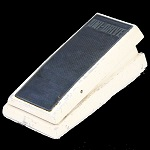
|
The UD-50 uses a wah-style treadle to roll up and down the drive,
there is a pedal range control and an input level control on the front
as well. Jimmy Page used one during the 1975 during the 1971 "Back to the Clubs" tour. Utilizing 2SC859 Transistors, this was really one of the first overdrive pedals.
|
70's
Shin-ei Companion FY-2

|
The FY-2 is well known for its raw, distinctive, chainsaw-type fuzz. There are two knobs on the pedal, volume and fuzz.
The effect is rather dark sounding so it works well with organ and bass. you can hear this effect used by Colin Greenwood on Radiohead's "Exit Music (For a Film)".
|
70's
Interfax Harmonic Percolator
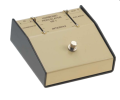
|
The Harmonic Percolator is a distortion pedal that was built by Ed Giese in Milwaukee, Wisconsin in the 1970's.
It used a silicon NPN transistor and a germanium PNP transistor in a design that passes even order harmonics while suppressing odd order harmonics.
These even order harmonics are thought to be more pleasing to the ear than odd order harmonics.
Steve Albini of the bands Shellac, Big Black, and Rapeman uses a Harmonic Percolator heavily.
|
70's
Kay Fuzz Tone

|
The Kay Fuzz Tone can be heard on the U2 song "Elevation".
|
70's
Olson Frizzy Fuzz

|
The same unit could be found as the Sekova SE2008 and SE2009 "Frizzy" Fuzz.
|
1971
Foxx Tone Machine

|
The FOXX Tone Machine is best loved for its wide range of fuzz. The Foxx tone machine was distributed as the Ibanez Tone Machine in 1972-73, these are very rare. It can get thick and hairy, but also can do a nice Fuzz Face imitation.
You also can switch between sustain and octave modes. That versatility has attracted users from Adrien Blew to Billy Gibbons of ZZ Top.
|
1971
EHX Little Muff Pi

|
The Little Muff Pi from Electro-Harmonix was the E-H Muff Fuzz effect packaged in a floor pedal enclosure. This circit ran until 1976 when it was repaced with an op amp version.
|
1971
Jordan Creator

|
Manufactured in the USA by Jordan Electronics, this pedal uses a nearly Identical circuit to the Big Muff housed in a wah enclosure. Supposedly one of the employees of Jordan brought in a Big Muff and everyone in the shop loved it. George Cole, the owner and circuit designer for Jordan, made some modifications to the component values. These pedals are very rare, and possibly the very first clone of the Big Muff.
|
1972
Roland AF-100 Bee Baa

|
A fuzz and treble boost in one case.
|
1973
EHX Big Muff Pi "Rams Head" v2
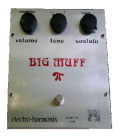
|
The "Rams Head" big muff was named due to the rams head graphic in the lower right corner of the face.
The major changes from the previous version were a larger case, the controls layout was changed to a stright line from the triangular pattern, and a circuit redesign.
While this pedal still uses PNP transistors, the design of the tone circuit gives this version a more pronounced mids scoop and a little less gain than the "Triangle" version.
This is the only Big Muff used by Dave Gilmour in the "The Wall" tour.
|
1973
Hawk I

|
The S. Hawk Ltd. Hawk I made it's debut in 1973. It is a switchable overdrive and distortion effect device.
A simple linear pre-amp, fuzz, head phone amp, and volume control.
|
1973
Hawk II Expander
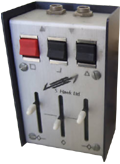
|
The Hawk II Tonal Expander has eq points of 170Hz, 550Hz and 2500Hz.These are not the points found on the typical recording and Hi Fi equalizers. More to the point, the Q or shape of the curve is quite different. Rory Gallagher frequesntly used this model booster. A Graphic Equalizer, Treble Booster, Bass Booster, Brite Switch, Pre-Amp, and Headphone Amp.
|
1973
Gretsch Contrafuzz
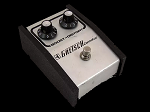
|
This one is a unique design based around a single 4558 chip where the fuzz signal is added to your clean boosted signal in contra-phase.
|
1973
Jen Jumbo Fuzz
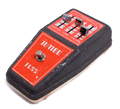
|
Jen Jumbo Fuzz made by Jen Elettronica in Italy. A modified Big Muff clone with a gate circuit, also rebranded as the Dallas Arbiter Jumbo Fuzz, Sam Ash Jumbo Fuzz, and Sam Ash Fuzzola II . It was built in Jen's Tonebender style case, with sliders on top instead of knobs. Based on the Jen case style used (with the battery door on the bottom), the numerical codes on the back, the techno font used (popular from 72 into the 1980's), packaging style, and other OEM versions dated the same way, I estimate this pedal was made circa 1973-75. The Dallas Arbiter Jumbo Fuzz first appeared in a 1973 Sound City price list and catalog.
|
1973
Gretsch Expandafuzz
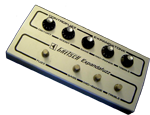
|
The Gretsch Expandafuzz included their Controfuzz, the Tremofect, the Freq-faze, and the Tone Divider circuits all in one housing.
|
1970's
Color Sound Supa Tonbender
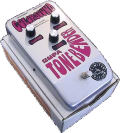
|
The Supa Tone Bender is a four transistor circuit, based on the Electro-Harmonix Big Muff PI.
|
1974
Maxon OD-801
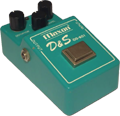
|
The Maxon OD-801 Distortion Sustainer was built by D&S. It was a modified Big Muff clone made by the Nisshin Onpa company in Japan. The exact pcb appeared in other Maxon pedals like the Maxon Magum Distortion MD-9 and Maxon Jet Driver JD-01.
|
|
1974
Ibanez OD850 Overdrive
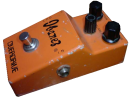
|
Based on the 4 transistor Big Muff circuit, the OD850 was produced by the Nisshin Onpa company in Matsumota, Japan. The effect has somewhat more refined sound than other clones of the circuit, due to a modified tone circuit.The Maxxon Maxon OD-801 uses the same circuit.
The first edition was discontinued in 1976. The OD-850 was available in the "0" sries from 1980 - 1981.
|
1974
Ibanez OD855 Overdrive-II

|
The first edition was discontinued in 1976. The OD-855 was available in the "0" sries from 1980 - 1981.
|
1974
Ibanez No. 59 Standard Fuzz
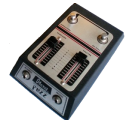
|
The Standard Fuzz circuit is identical to the Univox Super-Fuzz, except the input stage has been changed to use one J-FET instead of two transistors. This fuzz pedal has two octave fuzz settings, one with scooped mids and one with a really thick mid-range. The unit was branded under (and is identical to) a variety of names, including Mica Fuzz, Bruno Fuzz Machine, Aria Diamnond Fuzz and Fuzz Machine. The Ibanez Standard Fuzz is used by Dan Auerbach of the Black Keys. The effect was discontinued in 1980.
"I've got shelves of pedals, sick amounts of pedals. But I swear, I use the same pedals I've always played. I bought an early-1970s Ibanez Standard Fuzz pedal, the octave fuzz with the two sliders. I've been using it since the first record, and I cannot top it. It's got two basic tones, bassy or trebly, and I use it on bass and guitar. It's just wild. I also use those green Sovtek Big Muffs on the road. They're fun for blasting a bigger amp. But when you want to get character out of a little amp, you really can't beat those little Japanese fuzzes like the ones from Shin-ei. Those are my favorite, the absolute best." - Dan Auerbach of The Black Keys
|
1974
Ibanez No. 83 "New" Fuzz
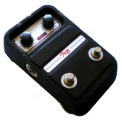
|
Discontinued in 1975.
|
1975
Foxx O.D. Machine

|
Baisclly this was a copy of the Univox Unidrive UD-50 using NPC3391 transistors. It was also released as the Turtle O.D. Machine.
|
1976
EHX Big Muff Pi "Red & Black" v3

|
When you say Big Muff, this is the graphic design people know, the classic american red & black.
This version moved to use NPN transistors. It's best described as Wilder and more "out of control" than it's predecessors. Though somewhat rare, there was a V3 made with a tone bypass switch like the later V5/6 Big Muffs. There was NO LED light on the V3. Many people confuse the later V9 Big Muff produced in 2000 with the V3, but none of the vintage USA Big muffs produced prior to 2000 included an LED light, nor a battery door on the botom. These had four rubber feet on the bottom.
|
1976
ColorSound Jumbo Tone Bender

|
The Jumbo Tone Bender is a three transistor circuit, based on the Electro-Harmonix Big Muff PI. Sola Sound made this pedal under various names, in various enclosures and for various distributors. It can be found in a narrow Colorsound enclosure with the same graphics as the late germanium Tone Benders, a wide Colorsound enclosure with different Jumbo Tone Bender graphics, in some Vox MKIII Tone Benders, in a different thin enclosure rebranded as B&M (Champion) Fuzz, B&M Fuzz Unit, CMI Fuzz Unit, G.B. Fuzz, G.B. Fuzz Unit or Pro Traffic Fuzz Unit or in a smaller enclosure labeled as the Eurotec Black Box Fuzz Module. It was also part of the Colorsound Supa Wah-Fuzz-Swell.
|
1976
Earth Sound Research Graphic Fuzz

|
The ESR Graphic Fuzz utilized a single LM741 op-amp, with no clipping diodes.
|
1976
Little Big Muff
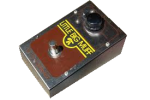
|
Little Big Muff Pi (EH-1009, EHSP1). One knob version of the Big Muff V3 from Electro-Harmonix. originally a Transistor circuit, it was replaced in 1978 by an opamp version only to go back to a transistor layout in 1979.
|
1978
Boss DS-1
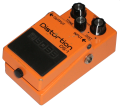
|
The Boss DS-1 is an icon in distortion pedals.
It features one tone knob, one level knob, and one distortion knob.
It can produce a thin, light, snappy distortion up to a heavy and harsh sound.
The DS-1 has been used by to many artists to list. You can hear it on Kurt Cobains guitar on the track "Smells Like Teen Spirit". Other users of this effect include Joe Satriani and Steve Vai. In the past I've found stock pedals to be a bit tame, the "Keeley" mods really bring this circuit alive.
|
1978
Deluxe Big Muff Pi
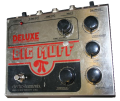
|
Vintage V5 Big Muffs and Deluxe Big Muffs use nearly the same op-amp circuit as the V4.The circuit was made with one of the popular 741 op-amps and one RC4558 dual op-amp, though occasionally V4 Big Muffs are seen with different chips.
|
1978
Pro Co Rat

|
The original RAT was developed in the basement of Pro Co's Kalamazoo, Michigan facility in 1978. In 1978, "The RAT" was being built as a custom-order product. Only twelve of these pedals, commonly referred to as the ōBud Box" RAT, were produced. Each pedal was built in a standard project box, hand painted, and hand drilled. By 1979, as the pedal became more popular, Pro Co began mass producing them. The Pro Co "The RAT" is a distortion pedal with a very simple circuit, based around a single op-amp, the LM308. The distortion is produced using a variable gain circuit with diodes shorting the output to ground to produce hard clipping of the input waveform. This distortion stage is followed by a passive tone filter and volume control. This is the same scheme as the Boss DS-1 distortion pedal, although there are major differences between the two circuits, therefore the sound of the two pedals are different. The most popular RAT pedal, the RAT2, features true-bypass switching. Since it's intorduction there have been many versions of RATs:
Juggernaut (1979)
RDDU (1984)
RAT 2 (1988)
Turbo RAT (1989)
Vintage RAT (1991)
BRAT (1997)
Roadkill (1997)
Deucetone RAT (2002)
Juggernaut Bass RAT (2003)
You Dirty RAT (2004)
Chinese RAT2 (2008)
'85 Whiteface RAT Reissue (2010)
The Pro Co RAT became very popular in the early 1980s, thanks in part to notoriety gained by its use by artists such as Jeff Beck and Joe Walsh.
|
1979
EHX Big Muff Pi "Op-amp" v4+5

|
While the graphics stayed the same, major changes were made under the hood. The circuit was redesigned to use op-amps instead of 4 transistors. Unlike the transistor versions, the tone is very consistent from unit to unit. This version is loved by some and hated by others. There was NO LED light on this version. Power was from a 9V battery or an AC power adaptor jack. The top had to be removed to change the battery. The v5 pedals included a 'tone bypass' switch. With the bypass switched on it removes the tone circuit, making a huge, peircing distortion. These older Big Muffs do not bypass the signal even when off. The signal still goes through and is amplified by the active op-amps, which can sometimes add a gain boost. The circuit was made with one of the popular 741 op-amps and one RC4558 dual op-amp, though occasionally V4 Big Muffs are seen with different chips. This is the same circuit found in the Deluxe Big Muff.
Creative urban Muff legend has it that Billy used a black Sovtek Russian Big Muff with a "creamy dreamer" mod, Billy has denied this. In fact he has plainly stated the pedal he used was an un-modded vintage american muff. This being the case the V4 Big Muff circuit is most likely the one heard on most of Smashing Pumpkins "Siamese Dream" and "Pisces Iscariot" albums.
|
1979
EHX Big Muff Pi "Red & Black Transistor" v6

|
There was NO LED light on this version. Power was from a 9V battery or an AC power adaptor jack. The top had to be removed to change the battery. The v6 is a transistor based Big Muff circuit. The tone is very similar to the V3 Big Muffs described above. In the examples I have played and owned the tone has more bass and can sound a bit flatter and fuzzier than typical V3 Muffs. Some have the mids slightly more scooped than the V3s. All of the V6 Muffs I have played have had more sustain/gain on tap than typical V3 pedals, but most were also much noisier, had less clarity for leads, and were more fuzzy sounding. The 'tone bypass' (not true bypass) switch was kept from the V3 and V5 versions, which allows you to completely remove the tone section from the circuit. This gives a raunchy, raw, and very loud tone, but lacks some of the tredemark Big Muff scooped mids character. The bass, treble, and fuzz varies slightly from unit to unit.The v6 was avaible in several different color combinations, including a reverse color imprint fo the stock muff graphics.
|
1979
Ibanez TS808
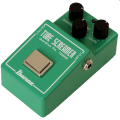
|
The first Tube Screamer was the green TS-808 overdrive pro.
It was preceded by the Orange "Overdrive" and green "Overdrive-II", and the red "Overdrive-II".
The overdrive and OD-II had a different, much more distorted, fuzzy circuit.
The TS-808 and its generation have small square chrome on/off touch-buttons.
Almost all TS-808's sound great. This pedal uses Japanese JRC4558 opamps.
One of the best know users to the Ibanez tube screamer is Stevie Ray Vaughan, he used the ts-808, ts-9, and It's a little known fact that nearing the end of his career he was using the TS-10.
|
1981
Morly Distortion 1
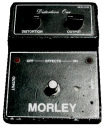
|
The Morley Distortion 1 (MOD-D1B) is IC based distortion built by Morley/Tel Ray using a single 741 op amp.
|
1981
Morly Deluxe Distortion
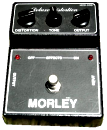
|
The Deluxe Distortion (MOD-DDB) featured "tone", "distortion", and "output" controls and utilized TL074 opamp based circuit.
|
1982
Ibanez TS9
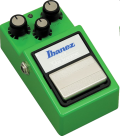
|
The TS-9 tube screamer is almost the same as the TS-808 internally.
Externally the on/off switch grew to fill about 1/3 of the effect with the Ibanez 9 series pedals.
The main change in the TS-9 circuit is in the output section.
This caused the tube screamer to be a bit brighter and less "smooth".
In later years the TS-9s were put together with seemingly random op-amp chips, instead of the JRC4558 which is called for in the schematics.
Some of these sound BAD, especially the JRC 2043DD chips. Changing these opamps is the main function of the "ts-9 to 808" mods you see everyone offering.
|
1982
Ibanez SD9

|
The Ibanez Sonic Distortion was discontiued in 1984.
|
1984
Ibanez OD9
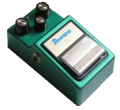
|
The OD9 uses the OD-850 pcb and most of the boxes are repainted TS9 and SD9 cases - it's literally built of leftovers. Produced in extremely small quantities, never found its way into the official Ibanez catalogs.
|
1984
Ibanez ST9
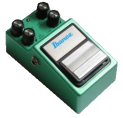
|
Ibanez ST9 Super Tube Screamer
|
1985
Ibanez STL "4 knob"
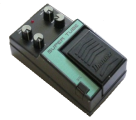
|
After Ibanez discontinued the "9" series, the MASTER or "L" series pedals were made.
This series was only made in 1985, and did not include a tube screamer in the lineup.
They did include the SUPER TUBE model STL, which is like a 4 knob tube screamer. The pcb is similar to ST9 Super Tube Screamer
using a pair of JRC4558D opamps. Discontinued in 1986.
|
1986
Ibanez TS10

|
The POWER SERIES or "10" series is very similar to the "L" Series, this line up including the TS-10 tube screamer.
Compared to a TS-808, a TS-10 has about 3 times more circuit changes than the TS-9 had.
This series was discontinued in 1989, some TS-10 pedals were made in Taiwan using an MC4558 chip.
All TS-10s (and other L and 10 series pedals) used cheap jacks and pots which were mounted to the boards instead of the cases.
In light of this it was not uncommen for them to break and fall apart. There is also a ribbon cable inside which attaches the pot board to the main board.
This pedal is not as sought after as the 9 and 808 models. It should be noted that this is the pedal SRV was using near the end.
|
1986
Ibanez DS10 Distortion Charger
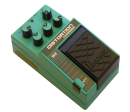
|
Ibanez DS10 Distortion Charger was discontinued in 1990.
|
1987
Ibanez FC10 Fat Cat
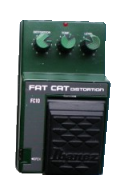
|
Ibanez FC10 Fat Cat distortion was discontinued in 1990.
|
1987
Boss Ds-2 Turbo Distortion
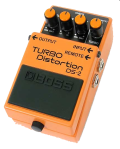
|
The Boss DS-2 Turbo Distortion is a developed version of the Boss DS-1 with two modes producing a distinctly different sound, "DS-1" and "Turbo". Musicians who have used this effect include:
John Frusciante - Red Hot Chili Peppers
Kurt Cobain - Nirvana
Kim Deal - Pixies, The Breeders
Billie Joe Armstrong - Green Day
Rivers Cuomo - Weezer
|
1990
Ibanez MT10 Mostortion
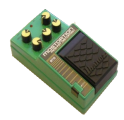
|
The Mosfet Distortion discontinued in 1993, most likely because of the mosfet CA3260 chip that was used in them
was discontinued. They come to be regarded as one of the best
distortions made, being favored as a secret weapon by Nashville players.
|
1991
EHX Russian Red Army Overdrive "BIg Muff Pi" v7
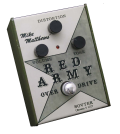
|
The actuall name "Big Muff" never appeared on this pedal.
It is a Big Muff transistor circuit, and all of the the later Russian Big Muffs were essentially this same pedal with different graphics.
This is probably the rarest of all the Russian made Muffs due to the classic "Star" graphic on the top panel and the small number that were manufactured.
|
1991
Russian EHX BIg Muff Pi Sovtek "Cival War" v7
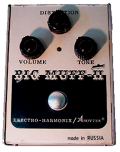
|
The circuit is identical to the second edition Red Army Overdrive and uses russian transistors.
This is the version Used by Gilmour on the "Momentary Lapse Of Reason" tour.
|
1993
Ibanez TS9 reissue
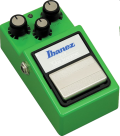
|
|
1994
Klon Centaur

|
The Centaur has been made available in several different forms. There are gold coloured boxes and silver ones, both cases sometimes carry a centaur graphic on them but not always. The circuitry inside has apparently not changed at all throughout all of the version. The effect was designed by Bill Finnegan.
ōģThe Centaur was designed, over a period of four years, to be an overdrive that works with your guitar and amp, and with the particular sound they create, rather than one that imposes its own sound. It does a better job of retaining the original tonality and response of your setup than anything else IÆm aware of; in the words of TrainwreckÆs Ken Fischer, a guy known to have pretty good ear, æThe Centaur seems to become part of your amplifierÆs tube circuits and doesnÆt feel or sound like you are using an outboard device.Æ What you end up with, when kicking the thing in, is simply a bigger, more focused rendition of the sound your guitar and amp were giving you to start withģö - Bill Finnegan
|
1994
Russian EHX BIg Muff Pi ōGREEN RUSSIANö v7
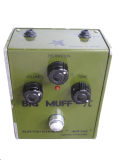
|
The first two revisons of this circuit board (#BM-1-01.00.000) were the same transistor based circuit as all of the previous russian muffs,with some capacitor value changes. The third revision (#BM-1-01.00.001) came with some new added circuit traces and more capacitor changes. These pedals were 9V battery operation only. A red LED light shows when the circuit is on.
|
1995
Zvex Fuzz Factory

|
The Fuzz Factory is a five-knob fuzz using two new old-stock sixties germanium transistors. The circuit is not modeled after any classic fuzz design. The five knobs are named for the parameters over which they seem to have the most control. The original pedals were mostly handbuilt and painted in Minnesota.
In December of 2004, Z.Vex released a new model of the Fuzz Factory, called the Vexter Series Fuzz Factory. The Vexter series differs from the Handpainted version in that it has a silkscreened enclosure and a shorter warranty period. This effectively lowers the price point, and makes both production easier for Z.Vex and allows the effect to become more accessible to musicians. The Vexter Fuzz Factory contains the same circuit as the original Fuzz Factory pedals, with the inclusion of modern touches such as an indicator LED and DC power jack for powering the fuzz with an adapter. As of August 2006, Vexter series Z.Vex pedal subassemblies are completed in Taiwan, but a large portion is still done in Minnesota.
|
1995
Morly Diamond Distortion

|
The Morley Distortion Distortion using a TL0741 op amp, very similar to their earlier "Deluxe Distortion" .
|
1998
Russian EHX BIg Muff Pi "BLACK RUSSIAN Large Case" v7

|
This is the same circuit and PCB trace as the third edition Green Russian Muffs.
The transistors were Russian E type and these pedals were 9V battery operation only.
A red LED light shows when the circuit is on.
|
1998
Ibanez TS9DX Turbo
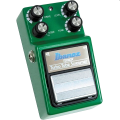
|
The TS9DX Turbo Tube Screamer was made available for those who want more volume, distortion, and low end.
It is the same as the TS9, but has an added knob which has four MODE positions.
Each position adds low end, increases volume, and actually decreases distortion.
|
1999
Russian EHX BIg Muff Pi Small "BLACK RUSSIAN" v8

|
This cricuit used a slightly modifies desing with some component changes.
The transistors used were of the BC549C or BC547C type.
Again power was supplied from a 9V battery only and a red led shows when the circuit is on.
|
2000
Ibanez TS7 "Tone Lok"
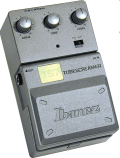
|
The TS7 TONE-LOK is made in Taiwan like the TS5, but in a metal case that will surely stand up better.
There are several circuit boards inside, they seem to be generic and several different effects can be built using the same boards.
These have a HOT mode switch for extra distortion and volume, which is quite useable.
Most TS7 pedals come with the correct JRC4558D chip. The TS7 is a lot cheaper than a TS9 but I'm not sure how they will stand up to abuse and time.
All the boards, connectors, and cables inside add a lot of complexity and there are many things to break. Most of the partinside are not standard so replacments may be hard to come by.
I do like the srping loaded retractable knobs, but again it's a proprietary part and would be hard to replace.
|
2000
EHX Big Muff Pi "NY Reissue" v9
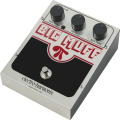
|
Fran Blanche, superb boutique pedal maker and founder of Frantone, was a designer at E-H from January 1999 to the Summer of 2000 and was the circuit designer for the reissue New York Big Muff.
The silk screened graphics were identical to the version 3-6 graphics, classic red and black. The main visual change is the addition of an led.
The first edition circuit board was marked EC3003-A and used four 2N5088 transistors.
In 2007 the board was changed to a second edition 3003-B schematic and with BC550C transistors, and in 2008 it was changed to a third edition 3003-C schematic, also with BC550C transistors.
The sound is slightly different for each edition.
The 3003-C changed the volume pot to a 500k linear taper pot, though the tone and sustain pots remained 100k linear taper as on previous Muffs.
The 2000-2001 Muffs were not true bypass, but after 2001 all V9 Muffs were made true bypass.
|
2001
Mogwai Big Muff Pi v9
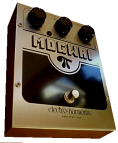
|
A special branded stock USA reissue made in a limited run for the band Mogwai.
|
2001
Double Muff
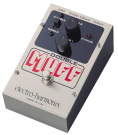
|
Double Muff. Two 1969 Muff Fuzz circuits in one box. Discontinued in 2008.
|
2004
Ibanez TS808 reissue
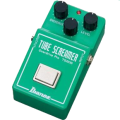
|
Ibanez finally reissued the TS-808 pedal due to popular demand.
It looks good, other than a slight color variance.
The reissue TS-808 uses the new TS9 reissue board, made by Ibanez, not the older MAXON board like the original TS808 and pre-2002 TS9.
It does have the correct JRC4558D op amp and output resistors, so it sounds better than the TS9 reissue.
|
2005
Ampeg Scrambler Reissue

|
I've heard only good things about this reissue. In fact Analog man noted a preferance to the tone of the new reissue in his comparison.
|
2006
EHX LITTLE BIG MUFF Pi "XO" v10
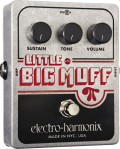
|
This is basically the same schematic as the large box V9 reissue Big Muff, though several component values are different.
The old style components were replaced with the newer micro "surface mounted" components.
Transistors in mine are unmarked, but these are probably BC550s, or 2N5088/MMBT5962 as the various schematics call for.
The circuit is true bypass. It runs off of either a 9V battery or an industry standard 9V AC adaptor.
For the first time, the AC polarity of a Big Muff was changed to standard polarity.
All previous USA Muffs were reverse polarity. This meant you could use a standard Boss type AC adaptor to power it.
|
2007
Devi Ever Vintage Fuzz Master
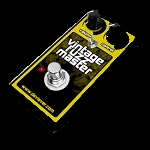
|
A quadruple silicon transistor fuzz with octave up fuzz
characteristics and a lot of gain.
|
2008
EHX "BASS" BIG MUFF Pi v11

|
This pedal is based on the Russian Big Muff and 1970s Big Muff circuits.
Circuit board is all "surface mounted" components.
Transistors are BC547C, same as the last black Russian Big Muffs.
The circuit is true bypass.
While the pedal was based on the Russian Big Muff circuit, it is not identical in tone to the Russians.
All toggle switch settings - bass boost, norm, and dry - sound good with bass.
For guitar, the normal setting sounds best, and is very close to the black Russian Big Muff tone, though not as noisy at full sustain.
|
2008
Flynnamps Hawk
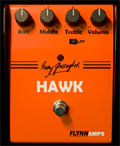
|
A clone of the original hawk expander.
|
2008
EHX USA "Tone Wicker" BIG MUFF Pi v12
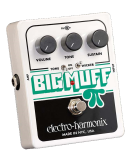
|
The curcuit is a different design than the V10 Little Big Muff.
The transistors are four BC550Cs. Early circuit boards are marked EC-D47, and later EC-D47 Rev. A.
The circuit is true bypass and uses "surface mounted" components like the V10 Muff.
Here is what Electo-Harmonix founder and owner Mike matthews had to say about this version:
"I wanted to hear again what the Big Muff sounded like if I hadnÆt inserted those 3 roll off capacitors
(Mike added these to Bob Myer's original Big Muff circuit design in 1969 to smooth out the raspiness),
so we put in a switch so that the user could have the option of taking them all out or leaving the Big Muff the way it was.
This time, the raspiness option sounded good to me, and it helped a lot to open up natural feedback between guitar and amp.
Then I tried a second thing, We put in a switch to completely take out the strong tone control of the Big Muff
(the same feature as on the old V5/V6 tone bypass Big Muffs). This gave a really wide sound."
The tone range of this pedal is quite broad.
It can match the tones of the V10 Little Big Muff somewhat in standard mode, but with the Wicker switched on
it becomes a much sharper and brighter sound, but not too harsh. The "buzzy-fizzy" sound that many Muff users
complain about with the V9 NYC reissue Big Muffs can be smoothed out with the Tone Wicker.
The "fuzz" tones it produces have much more range than previous Big Muffs.
While it sounds good do note that compared to a vintage V1 or V2 Muff, it sounds nothing like them.
|
2010
EHX GERMANIUM 4 BIG MUFF Pi v13
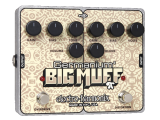
|
This is a completely brand new circuit design, not based on the common four stage Big Muff circuit at all.
The design incorporates two independant circuits based on Bob Myer's original designs. Each includes two Germanium transistors.
The four NOS NKT275 transistors in the G4BM are evaluated in the standard listening QC check that is done with every EHX pedal to determine if the pedals is suitable to go out the door. How long these NOS transistors will be available is unknown.
"The G4BM definitely has its own sound. But with the adjustability of the circuit, you can get a wide variety of tones, including more vintage fuzz tones, OD tones, as well as raunchy distortion. It doesnÆt have that great saturation as the Big Muff though, as we were aiming for more of a Distortion/Over Drive type of thing...What we came up with was a pedal that captures the warmth of the germanium sound and is capable of going from completely clean, to warm and smooth, to insane and over the top." - EXH designer Daniel Shin
|
2018
EHX Flatiron Fuzz

|
Flatiron Fuzz is a classic op-amp powered fuzz/distortion. With its
late 70s style circuit and symmetrical hard clipping, it EHX's take
on the RAT2 pedal.
|
2019
Danelectro 3699 Fuzz
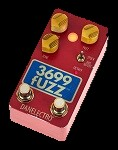
|
Created Steve Ridinger, the designer of the original Foxx Fuzz circuit, this
is an updated recreation of that fuzz box. It has been updated so the
octave is more pronounced and foot switchable. The tone is also
warmer, and there is a ŌĆ£mids boostŌĆØ toggle that counteracts the mid
cut of the original circuit.
|
2019
Eisenhower Fuzz
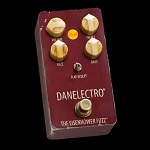
|
Clone of the Super fuzz Circuit with increased gain and added EQ
|
2019
Danelectro Breakdown

|
Danelectro clone of the Univox unidive, without the foot pedal.
|
2020
Danelectro Roebuck
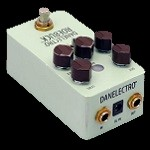
|
Danelectro clone of Ibanez Mostortion
|
|
 |
|

|
|
|
Copyright © HewittsGarageStudio.com, all rights reserved |
|
| |